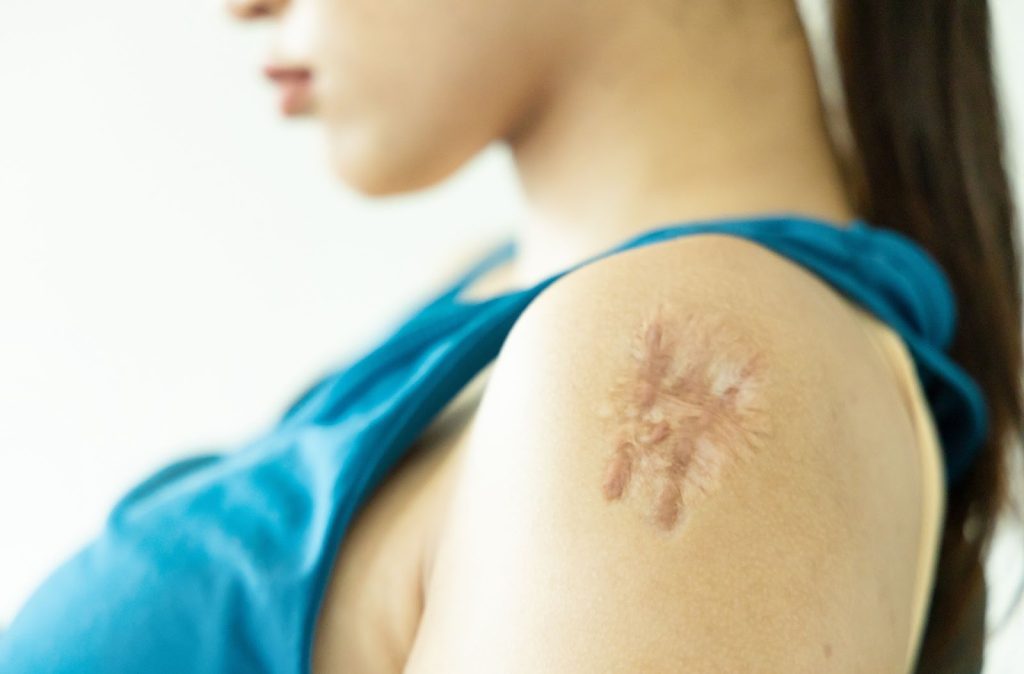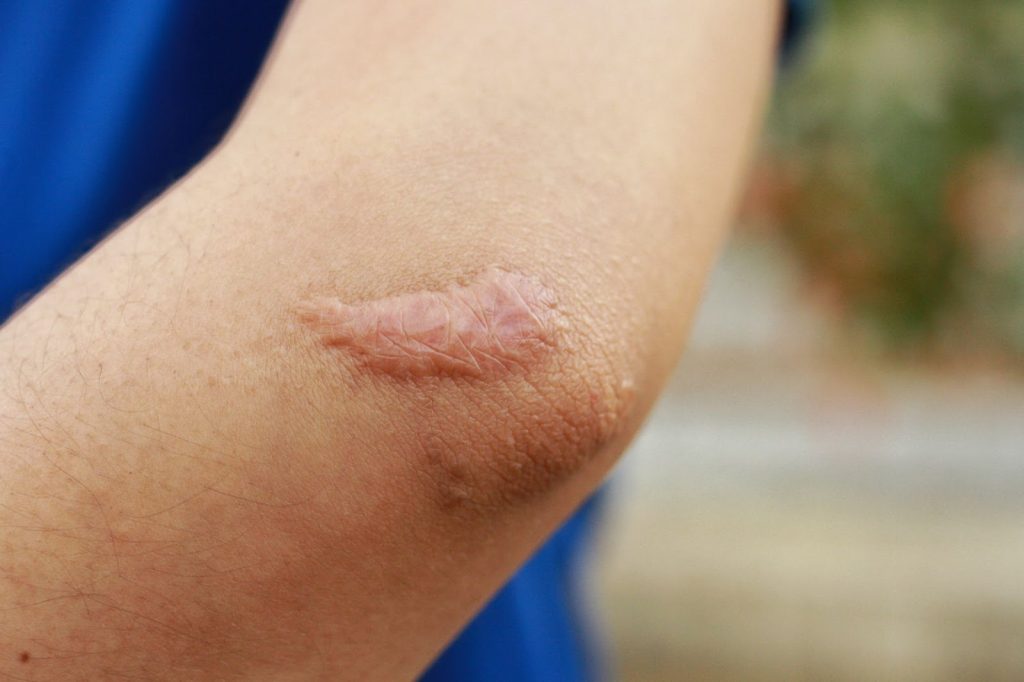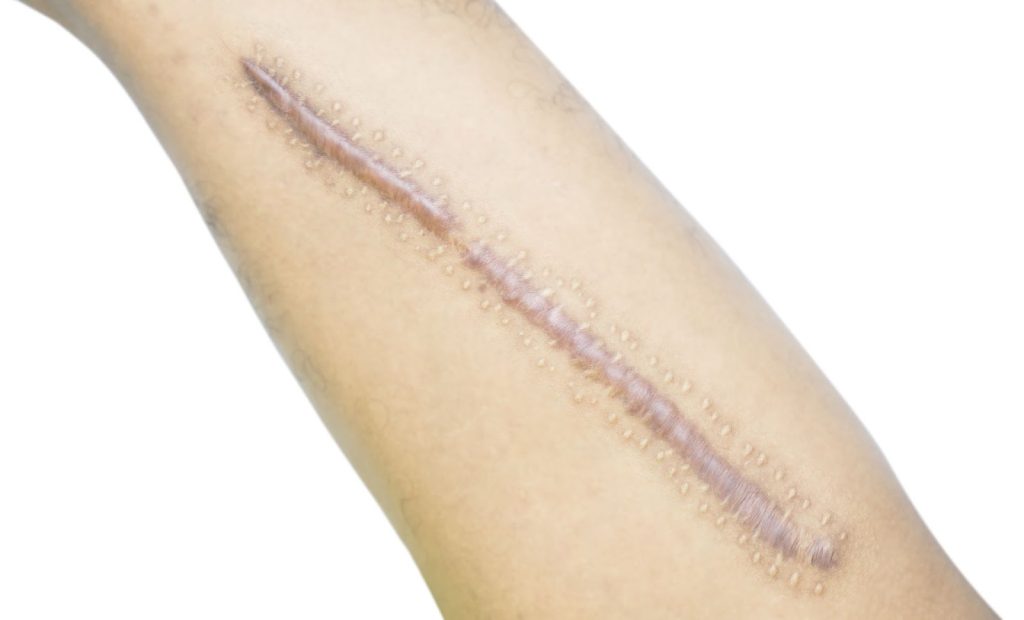What are keloids and hypertrophic scars?
Scars are the body’s natural way of healing and replacing lost or damaged skin. Usually composed of fibrous tissue, scars may form for various reasons but mainly act as the final result of a wound’s healing process. Regular scars appear flat on the skin’s surface layer, atrophic scars appear sunken or depressed, while hypertrophic scars and keloids appear raised.
Raised scars are a type of scar that differs from normal, flat scars in that they are elevated above the surrounding skin surface. There are two main types of raised scars: hypertrophic scars and keloids. Although both are raised scars, there are some key differences between hypertrophic scars and keloids; these are:
- Hypertrophic scars remain within the boundary of the injury, while keloids tend to extend beyond the injury site.
- Keloids often have a shiny and smooth appearance, while hypertrophic scars are matte and tend to be slightly rougher than regular skin.

What causes hypertrophic scars and keloids?
One of the body's reactions to injury is to produce collagen, a vital component of the wound-healing process. After an injury, collagen helps to form a scaffold for new tissue growth, facilitating the repair and regeneration of damaged skin or other tissues. Hypertrophic and keloids occur due to an overproduction of collagen, leading to the scar tissue being raised and thickened.
Common causes of injury which may result in keloids and hypertrophic scars include:
- Trauma
- Burn wounds, primarily second and third-degree burns
- Insect bites
- Skin piercings
- Systemic body inflation
- Acne
- Chickenpox
- Folliculitis
- Surgery
What are the symptoms of keloids and hypertrophic scars?
If you are experiencing one or more of the following symptoms during the healing process of a wound, it may be due to the emergence of a keloid or hypertrophic scar:
- Hard or thickened raised skin over the site of the wound
- Pink, red, or purple skin colouration over the wound
- Scar tissue on the upper part of your body, including back, chest, shoulders, upper arms, neck, ears, and joints (though these scars may also appear on the lower part of your body as well)
- Develops one to two months (or beyond) after an injury
- Varied in texture, from soft to hard to rubbery
- Shiny, hairless, lumpy texture on the skin.
- Itchy, causes irritation, tender, and some pain
- Scars over joints that limit the joint’s regular movements

Are hypertrophic scars and keloids painful?
Hypertrophic scars and keloids can sometimes be associated with symptoms such as pain, itching, tenderness, or discomfort, but this varies from person to person and depends on factors such as the size, location, and severity of the scar.
Individuals with hypertrophic scars and keloids may experience tenderness, itching, and discomfort in the affected area. While these scars are not typically painful, they may cause discomfort or pain if located in areas where they are subject to friction, pressure, or tension. For example, keloids on earlobes or over joints may be painful due to constant movement or irritation.
Who is at risk of developing hypertrophic scars and keloids in Singapore?
Although anyone is at risk of developing these raised scars, several factors increase an individual’s risk of developing them. Risk factors for developing hypertrophic scars and keloids include:
- Genetics: a family history of raised scars, such as hypertrophic scars or keloids, increases an individual’s risk of developing them.
- Age: these scars tend to be more common in young individuals whose bodies tend to mount a more robust or enthusiastic response to wound healing.
- Injury type or severity: injuries that cause deep wounds or significant tissue manipulation are more likely to result in hypertrophic scars or keloids.
- Skin tone: individuals with darker skin tones are more prone to hypertrophic scars or keloids. This increased susceptibility may be related to differences in skin structure, collagen composition, and inflammatory response.
- Hormones: hormonal changes, such as those occurring during puberty, pregnancy, or hormonal therapies, may influence the body's response to injury and increase the likelihood of hypertrophic scar or keloid formation.

How are hypertrophic scars and keloids diagnosed?
While hypertrophic scars and keloids are easily identified upon visual examination, there are additional diagnostic practices that must be conducted; these are:
- Medical history: your doctor will ask about your medical history, including any previous skin injuries, surgeries, or conditions that may have led to scar formation. They may inquire about factors such as the timing of scar development, associated symptoms (such as itching or pain), and any family history of abnormal scarring.
- Skin biopsy: a skin biopsy may be performed to confirm the diagnosis, especially if there is uncertainty about the nature of the scar or if skin cancer is suspected.
- Imaging studies: in rare cases, imaging studies such as an ultrasound or magnetic resonance imaging (MRI) may be required to assess the extent of scar tissue and its relationship to underlying structures.
What are the treatment options for hypertrophic scars and keloids in Singapore?
The desired outcome for hypertrophic scars and keloids is to soften it, reduce the colour contrast, ease existing pain caused by the scar, and reduce its overall size. While the options to assist facilitating this matter differ based on the amount of time that has passed, the most common treatments for keloids and hypertrophic scars in Singapore include:
- Laser therapy: pulsed dye lasers or long pulsed lasers are used to treat hypertrophic scars and keloids, as they target blood vessels within the scar, thereby removing them to prevent it from growing. Such a procedure can also lighten the colouration and reduce pain, itchiness, or hardness. Fractioned lasers can also insert microscopic holes in the scar to soften and remodel it.
Frequently asked questions
Can hypertrophic scars turn into keloids?
While hypertrophic scars occur more commonly than keloids and possess similarities in composition and treatment methods, hypertrophic scars will not develop into keloids.
Are hypertrophic scars and keloids cancerous?
Hypertrophic scars and keloids are not cancerous. Despite this, if more than one appears on your body, it is a cause for concern and will require further checking. Scars can sometimes act as a cover to hide skin cancer, with growths and markings such as hypertrophic scars and keloids being potential grounds for skin cancer to bloom.
What is the difference between hypertrophic scars and keloids?
Hypertrophic scars and keloids are both raised scars and occur due to an overproduction of collagen. However, they do have some differences. Keloids grow beyond the injury site, while hypertrophic scars tend to be confined to the boundaries of the injury. Hypertrophic scars have an irregular texture, while keloids are smooth and shiny. Hypertrophic scars are softer and more pliable than keloids, which tend to be rubbery and firmer in nature.

